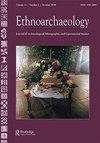火的地理民族考古学:当代背景下火残留物的地质考古调查及其考古意义
IF 1.3
0 ARCHAEOLOGY
引用次数: 2
摘要
以微观和化学遗迹为重点的地质考古学对考古火灾的研究做出了巨大贡献。在过去的二十年中,地质考古学家采用的方法之一是使用民族考古学来收集参考材料并构建模型,以了解火灾残留物如何在考古记录中形成并保存或恶化。地理民族考古学利用当代背景来调查现存的和最近被遗弃的遗址,以便将人类行为与微观和化学标记的形成直接联系起来,并遵循影响考古记录形成的沉积后过程。本文通过对几个关键案例研究及其考古意义的考察,回顾了地理民族考古学对与火灾残留物相关的考古形成过程研究的贡献。本文章由计算机程序翻译,如有差异,请以英文原文为准。
Geo-ethnoarchaeology of Fire: Geoarchaeological Investigation of Fire Residues in Contemporary Context and its Archaeological Implications
ABSTRACT Geoarchaeology focusing on microscopic and chemical remains has contributed greatly to the study of archaeological fire. One of the methodological approaches geoarchaeologists have adopted in the last two decades is the use of ethnoarchaeology to collect reference materials and construct models for how fire residues are formed and preserve or deteriorate in the archaeological record. Geo-ethnoarchaeology uses contemporary contexts to investigate both living and recently abandoned sites in order to directly link human behavior with the formation of microscopic and chemical markers and to follow the post-depositional processes, which affect the formation of the archaeological record. This article reviews the contribution of geo-ethnoarchaeology to the study of archaeological formation processes associated with fire residues through the examination of several key case studies and their archaeological implications.
求助全文
通过发布文献求助,成功后即可免费获取论文全文。
去求助
来源期刊

Ethnoarchaeology
ARCHAEOLOGY-
CiteScore
1.60
自引率
0.00%
发文量
10
期刊介绍:
Ethnoarchaeology, a cross-cultural peer-reviewed journal, focuses on the present position, impact of, and future prospects of ethnoarchaeological and experimental studies approaches to anthropological research. The primary goal of this journal is to provide practitioners with an intellectual platform to showcase and appraise current research and theoretical and methodological directions for the 21st century. Although there has been an exponential increase in ethnoarchaeological and experimental research in the past thirty years, there is little that unifies or defines our subdiscipline. Ethnoarchaeology addresses this need, exploring what distinguishes ethnoarchaeological and experimental approaches, what methods connect practitioners, and what unique suite of research attributes we contribute to the better understanding of the human condition. In addition to research articles, the journal publishes book and other media reviews, periodic theme issues, and position statements by noted scholars.
 求助内容:
求助内容: 应助结果提醒方式:
应助结果提醒方式:


